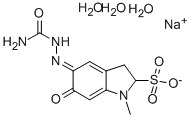Aminomethanesulfonic acid
- CAS NO.:13881-91-9
- Empirical Formula: CH5NO3S
- Molecular Weight: 111.12
- MDL number: MFCD00008124
- EINECS: 237-649-6
- SAFETY DATA SHEET (SDS)
- Update Date: 2025-01-27 09:38:02

What is Aminomethanesulfonic acid?
Chemical properties
White Powder
The Uses of Aminomethanesulfonic acid
Aminomethanesulfonic acid can be used as a reactant to synthesize: 1-Sulfomethyltetrazole-5-thiol disodium salts, which are useful key intermediates for the preparation of cefonicid sodium. Tridentate N-(2-hydroxybenzyl)aminomethane sulfonic acid Schiff-base ligand by reacting with salicylaldehyde.
It can also be used to functionalize the surface of single-walled carbon nanotubes (SWCNT) or porous metal-organic frameworks (MOF) to introduce the sulfonic acid functional groups for the preparation of nanocomposites.
Properties of Aminomethanesulfonic acid
| Melting point: | 184 °C (dec.) (lit.) |
| Density | 1.339 (estimate) |
| refractive index | 1.5130 (estimate) |
| storage temp. | Inert atmosphere,Room Temperature |
| solubility | 17g/l |
| form | Fine Powder |
| pka | pK1: 5.57(+1) (25°C) |
| color | White |
| PH | 3.2 (17g/l, H2O, 17℃) |
| Water Solubility | Soluble in water. (17 g/L) at 17°C |
| BRN | 1811756 |
| CAS DataBase Reference | 13881-91-9(CAS DataBase Reference) |
| NIST Chemistry Reference | Aminomethanesulfonic acid(13881-91-9) |
| EPA Substance Registry System | Methanesulfonic acid, amino- (13881-91-9) |
Safety information for Aminomethanesulfonic acid
| Signal word | Danger |
| Pictogram(s) |
 Corrosion Corrosives GHS05 |
| GHS Hazard Statements |
H314:Skin corrosion/irritation |
| Precautionary Statement Codes |
P260:Do not breathe dust/fume/gas/mist/vapours/spray. P280:Wear protective gloves/protective clothing/eye protection/face protection. P301+P330+P331:IF SWALLOWED: Rinse mouth. Do NOT induce vomiting. P303+P361+P353:IF ON SKIN (or hair): Remove/Take off Immediately all contaminated clothing. Rinse SKIN with water/shower. P305+P351+P338:IF IN EYES: Rinse cautiously with water for several minutes. Remove contact lenses, if present and easy to do. Continuerinsing. |
Computed Descriptors for Aminomethanesulfonic acid
| InChIKey | OBESRABRARNZJB-UHFFFAOYSA-N |
New Products
4,4-Difluoropiperidine hydrochloride tert-butyl 9-methoxy-3-azaspiro[5.5]undecane-3-carboxylate Indole Methyl Resin N-Isopropylurea N,N-Dicyclohexylcarbodiimide(DCC) MELDRUMS ACID 5-METHYLISOXAZOLE-4-CARBOXYLIC ACID Magnessium Bis glycinate Zinc ascorbate 1-bromo-2-butyne 2-acetamidophenol 9(10H)-anthracenone Erythrosin B, 4-Piperidinopiperidine 2-((4-morpholinophenylamino) (methylthio) methylene) malononitrile 2,4-dihydroxybenzaldehyde 3-(4-morpholinophenylamino)-5-amino-1H-pyrazole-4-carbonitrile Methyl 2-methylquinoline-6-carboxylate 2,6-dichloro-4-nitropyridine 4-Bromo-2-chlorobenzonitrile 2-(benzylamino)acetic acid hydrochloride 4-(tert-Butoxycarbonylamino)but- 2-ynoic acid 3,4-dihydro-2H-benzo[b][1,4]dioxepine 1-Phenyl-1-cycloprppanecarboxylicacidRelated products of tetrahydrofuran




![sodium 5-[(aminocarbonyl)hydrazono]-2,3,5,6-tetrahydro-1-methyl-6-oxo-1H-indole-3-sulphonate](https://img.chemicalbook.in/CAS/GIF/1428-72-4.gif)



You may like
-
 Aminomethanesulfonic acid 98% CAS 13881-91-9View Details
Aminomethanesulfonic acid 98% CAS 13881-91-9View Details
13881-91-9 -
 Aminomethanesulfonic Acid CAS 13881-91-9View Details
Aminomethanesulfonic Acid CAS 13881-91-9View Details
13881-91-9 -
 Aminomethanesulfonic acid CAS 13881-91-9View Details
Aminomethanesulfonic acid CAS 13881-91-9View Details
13881-91-9 -
 Aminomethanesulfonic AcidView Details
Aminomethanesulfonic AcidView Details
13881-91-9 -
 3-(4-amino-1-oxoisoindolin-2-yl)-1-methylpiperidine-2,6-dione 98%View Details
3-(4-amino-1-oxoisoindolin-2-yl)-1-methylpiperidine-2,6-dione 98%View Details -
 20677-73-0 (2,2-diethoxyethyl)methylamine 98%View Details
20677-73-0 (2,2-diethoxyethyl)methylamine 98%View Details
20677-73-0 -
 3-(4-(hydroxyamino)-1-oxoisoindolin-2-yl)piperidine-2,6-dione 98%View Details
3-(4-(hydroxyamino)-1-oxoisoindolin-2-yl)piperidine-2,6-dione 98%View Details -
 57381-49-4 2-bromo-4-chlorobenzonitrile 98%View Details
57381-49-4 2-bromo-4-chlorobenzonitrile 98%View Details
57381-49-4
Statement: All products displayed on this website are only used for non medical purposes such as industrial applications or scientific research, and cannot be used for clinical diagnosis or treatment of humans or animals. They are not medicinal or edible.
